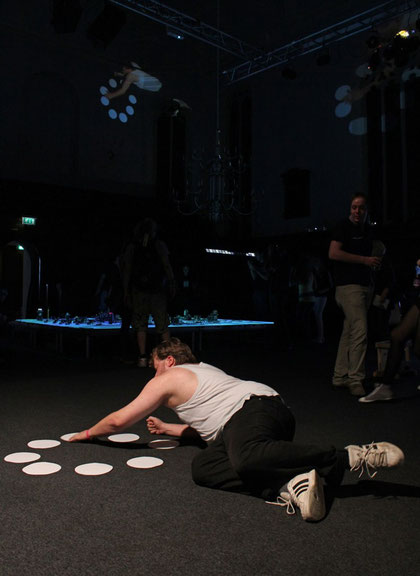Constant Dullaart lies on the ground in an exhibition gallery, a beam of light drawing the audience’s attention towards him while his actions are simultaneously recorded and projected in the room. Spread out in front of him are eight circular elements arranged in a ring. One by one the artist moves the white circles one position further in a clockwise direction, making the figure appear to rotate. The image created here has been well-known to us at the latest since 2005. When the video platform YouTube was founded, a certain animation became part of the world of moving images on our computers. It shows that the video you are currently trying to watch has not fully loaded yet— buffering. YouTube on the Floor (2011) is the name of the performance, which the artist describes as an analogue animation in real space and presents as a video documentation in virtual space, as a further contribution to the endless cycle of image production and reproduction.
The fact that for Constant Dullaart digital media are not only a way to transport content but also the object of reflection is also demonstrated by his work DVD Screensaver Performance (2011). Here we can see the artist sitting in all kinds of different places, such as atop a boulder in the Joshua Tree desert landscape, in a tracksuit in his living room, or in the midst of the Museum of Applied Art’s collection during a stay in Vienna. In all three of these settings, the artist is holding signs picturing the DVD logo, each sign a different color. For several minutes he moves the signs diagonally from one edge of the screen to the other. Whenever the oval logo touches the border of the video display, the artist changes to a different sign and therefore different color. Through the use of little more than cardboard signs, Dullaart imitates the DVD logo’s movement back and forth across the screen when there is no disk in the drive—by deploying his own body. Like YouTube on the Floor, this work is an attempt at looking more closely at a procedure that we take for granted in our everyday lives in order to demonstrate to viewers the performative potential of technological arrangements as well as acting out their factory-set, default design.
Despite his extensive self-reflection, Dullaart abandons the strict and stern aspects of so-called “media art” just as he leaves behind the utopias that the novelty and exclusivity of technologies such as the internet promised in the early 1990s. He moves freely and casually between different media and formats, which means that there are often several versions of one and the same work, either in the form of adaptations by the artist himself or as an appropriation by other internet users or artists. A work that is exemplary of this method is YouTube as a Sculpture (2009). In the course of Dullaart’s work focusing on the functional elements of YouTube, such as the aforementioned loading animation, the play button, or the red line at the bottom edge of the player showing the elapsed time, the artist suspended eight Styrofoam spheres from the ceiling of a darkened room in the shape of a ring, adjusting their position to the Black Box’s dimensions. A flashing light that illuminates the spheres one by one gave viewers the impression that they themselves were inside a video that was stuck in its loading process. “The best thing about this piece is that viewers have begun to ‘versionize’ the sculpture, by filming it using mobile devices and uploading the recordings to YouTube,” said the artist in an interview. “What to me really made this work successful was how the audience themselves functioned as a medium for uploading the material, continuing the discussion about YouTube that I started.”
Constant Dullaart’s artistic practice explores the multifaceted language of images circulating around the Web, as well as their constant re-contextualization either within their own medium or externally. With his performative artworks, the artist, who was born in 1979 and currently lives in Amsterdam and Berlin, digs deep into the cache of an interconnected system of cultural production, without however reducing the medium to its technological characteristics. His central concern is instead the universally uniform appearance of our monitor displays as well as the largely unquestioned use of standardized interfaces, which the artist manipulates in a way that reveals what effect these may have on their behavior of users.
www.constantdullaart.com
www.youtube.com/user/constantdullaart
Translated by Jennifer Taylor
